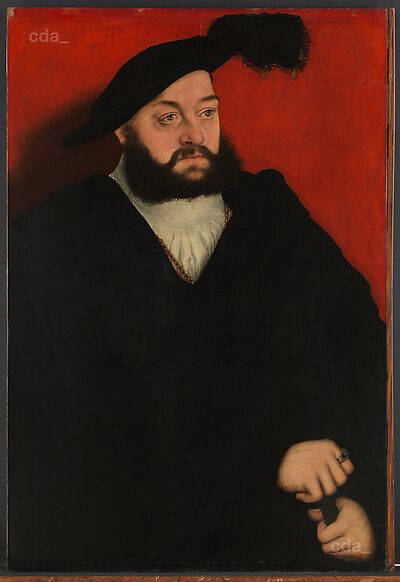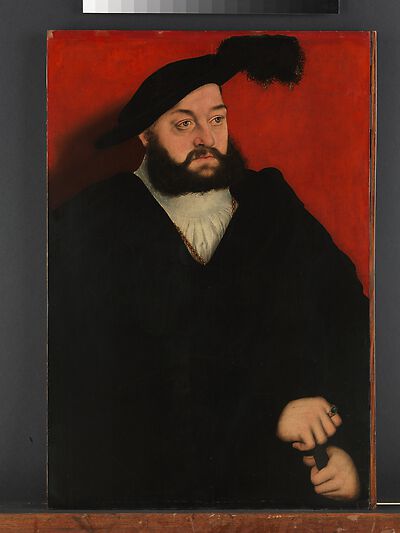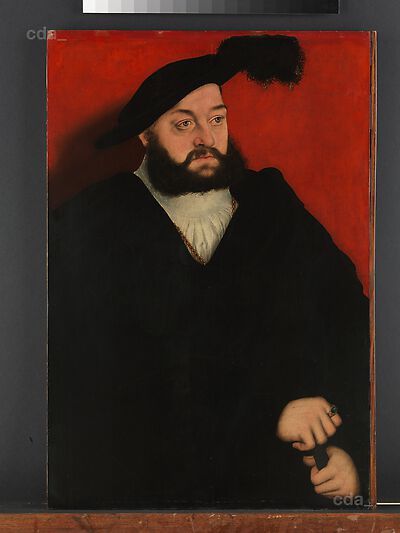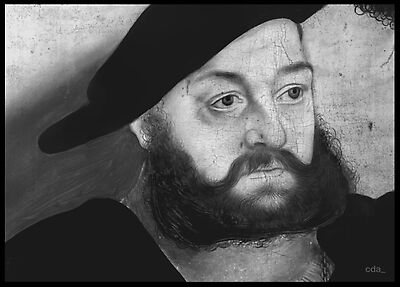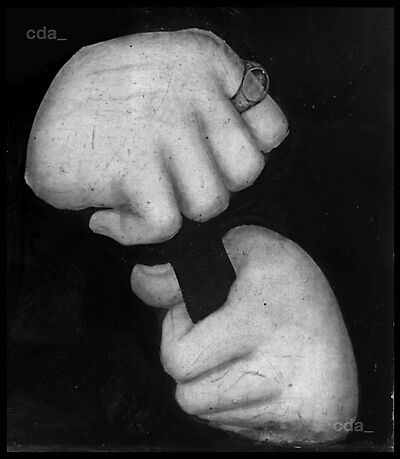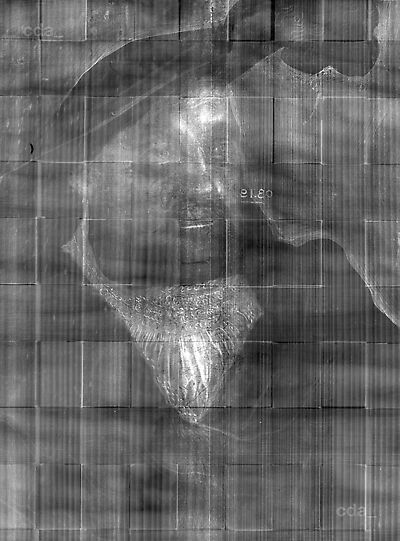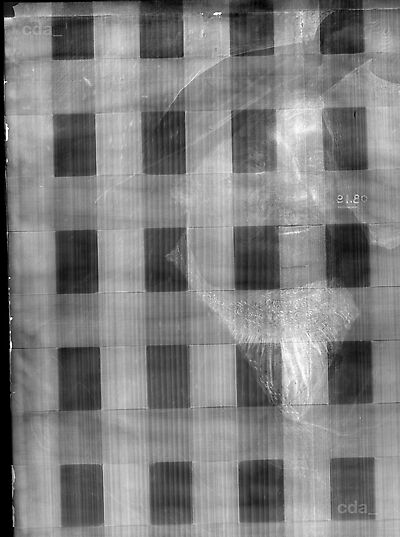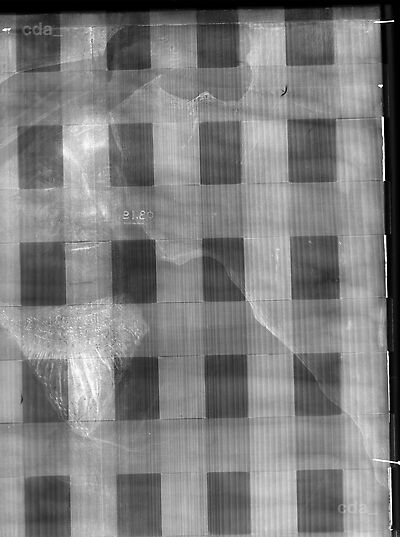- Attributions
-
Lucas Cranach the Elder
Lucas Cranach the Younger
Attributions
| Lucas Cranach the Elder | [The Metropolitan Museum of Art, revised 2011] |
| Lucas Cranach the Younger | '[...] more likely by Lucas Cranach the Younger' |
- Production dates
- about 1537
1531
Production dates
| about 1537 | [The Metropolitan Museum of Art, revised 2011] [Snyder, Cat. New York 1987, 15, 111, Plate 77] [Friedländer, Rosenberg 1932, 92, No. 341b] |
| 1531 | [Kuhn, Exhib. Cat. Cambridge, Mass., 1936, 42-43, No. 131, plate 24] erroneously states that the painting is dated 1531 and signed with a dragon with wings erect. |
- Dimensions
- Dimensions of support: 65.3 x 44 x 0.9 cm (including later wood strips added at top and bottom, each 3/8 × 17 5/16 in. (.95 × 44 cm))[1]
Dimensions
Dimensions of support: 65.3 x 44 x 0.9 cm (including later wood strips added at top and bottom, each 3/8 × 17 5/16 in. (.95 × 44 cm))[1]
Dimensions of the painted surface: 63.3 x 44 cm
Depth of cradle: 1.2 cm
[1][Cat. New York 2013, 69, No. 15]
[The Metropolitan Museum of Art, revised 2011]
- Signature / Dating
None
- Inscriptions and Labels
Reverse of the panel on the cradle:
- central vertical cradle member:
Handwritten in a dark pencil or crayon '7665', (corresponding …Inscriptions and Labels
Stamps, Seals, Labels:
Reverse of the panel on the cradle:
- central vertical cradle member:
Handwritten in a dark pencil or crayon '7665', (corresponding to the item number assigned to this painting in the 1907 Kleinberger Galleries inventory).
[US_MMANY_08.19_FR424B_2008-04_ExaminationandConditionReport.doc]
- in red, 08.19
[Cat. New York 2013, 69, No. 15]
- Owner
- The Metropolitan Museum of Art, New York
- Repository
- The Metropolitan Museum of Art, New York
- Location
- New York
- CDA ID
- US_MMANY_08-19
- FR (1978) Nr.
- FR424B
- Persistent Link
- https://lucascranach.org/en/US_MMANY_08-19/
- central vertical cradle member:
Provenance
- Julius Alexander Baumgärtner, Leipzig
- before 1851 reportedly sold to a collector in Cologne
- after 1851 in a private collection, Cologne
- until 1907 in the collection of Graf Hans Wilczek, Kreutzenstein Castle, near Vienna
- 1907 sold to Kleinberger
- 1907-8 acquired by the MMA from Kleinberger, Paris, 1907-8
[The Metropolitan Museum of Art, revised 2011]
Exhibitions
New York 1956, suppl. No. 197
Literature
| Reference on page | Catalogue Number | Figure / Plate | |||||||||||||||
| Cat. New York 2013 | 69-72 | No. 15 | |||||||||||||||
|
|||||||||||||||||
| Löcher 2007 | 40 | ||||||||||||||||
|
|||||||||||||||||
| Cat. New York 1995 | Fig. p. 220 | ||||||||||||||||
|
|||||||||||||||||
| Montout 1994 | 53 | ||||||||||||||||
|
|||||||||||||||||
| Cat. New York 1987 | 15, 111 | Plate 77 | |||||||||||||||
|
|||||||||||||||||
| Cat. New York 1980 | 36 (Vol. 1) | Fig. p. 296 (Vol. 2) | |||||||||||||||
|
|||||||||||||||||
| Friedländer, Rosenberg 1979 | 156 | No. 424B | |||||||||||||||
|
|||||||||||||||||
| Exhib. Cat. Vienna 1972 | 54 | under No. 78 | |||||||||||||||
|
|||||||||||||||||
| Fry, Sutton 1972 | 294 | No. 2 | |||||||||||||||
|
|||||||||||||||||
| Cat. Aschaffenburg 1964 | 43 | ||||||||||||||||
|
|||||||||||||||||
| Rosenberg 1960 | 31 | ||||||||||||||||
|
|||||||||||||||||
| Held 1949 | 140 | ||||||||||||||||
|
|||||||||||||||||
| Cat. New York 1947 | 204 | ||||||||||||||||
|
|||||||||||||||||
| Zimmermann E. H. 1942 A | 2-4 | ||||||||||||||||
|
|||||||||||||||||
| Exhib. Cat. Cambridge, Mass. 1936 | 42-43 | No. 131 | Plate 24 | ||||||||||||||
|
|||||||||||||||||
| Friedländer, Rosenberg 1932 | 92 | 341b | |||||||||||||||
|
|||||||||||||||||
| Cat. New York 1931 | 74 | ||||||||||||||||
|
|||||||||||||||||
| Parker 1927 | 17 | Fig. p. 24 | |||||||||||||||
|
|||||||||||||||||
| Cat. New York 1914 | 52 | ||||||||||||||||
|
|||||||||||||||||
| Fry 1908 | 88 | Fig. p. 87 | |||||||||||||||
|
|||||||||||||||||
| Metropolitan Museum 1908 A | 234 | ||||||||||||||||
|
|||||||||||||||||
| Metropolitan Museum 1908 B | 62 | ||||||||||||||||
|
|||||||||||||||||
| Schuchardt 1851 C | 88-89 | 340 | |||||||||||||||
|
|||||||||||||||||
Research History / Discussion
'The sitter was a member of the ducal or Albertine branch of the Saxony court at Wittenberg. There are two versions of this painting by Lucas Cranach the Younger. One, bust-length, with a light blue background (Staatsgalerie Aschaffenburg, Germany) and another, miniature version, also against a blue background (Kunsthistorisches Museum, Vienna). A probable copy of the MMA portrait, by the Monogrammist IS (or JS), is in the Schlossmuseum, Gotha.'
[http://www.metmuseum.org/works_of_art/collection_database/european_paintings/john_1498_1537_duke_of_saxony_lucas_cranach_the_elder/objectview.aspx?page=1&sort=6&sortdir=asc&keyword=cranach&fp=1&dd1=11&dd2=0&vw=1&collID=11&OID=110000470&vT=1&hi=0&ov=0] (accessed 08.05.2011)
[Fry 1908, 88, Fig. p. 87] 'notes that no clue has been found to identify the sitter; compares it to Cranach's portrait of Johann Frederich der Grossmuthige dated 1531 (Louvre, Paris) and assigns it to about the same period.'
[http://www.metmuseum.org/works_of_art/collection_database/european_paintings/john_1498_1537_duke_of_saxony_lucas_cranach_the_elder/objectview.aspx?page=1&sort=6&sortdir=asc&keyword=cranach&fp=1&dd1=11&dd2=0&vw=1&collID=11&OID=110000470&vT=1&hi=0&ov=0] (accessed 08.05.2011)
'Monsieur Kleinberger. Letter. January 12, 1908, reports that Dr. Friedländer, Dr. Bode, M. Hulin de Gand, and M. Cardon de Bruxelles not only confirm that this painting is by Cranach the Elder, but consider it a masterpiece by him; notes that he bought it directly from count Hans Wilczek at his chateau in Kreutzenstein, near Vienna.'
[http://www.metmuseum.org/works_of_art/collection_database/european_paintings/john_1498_1537_duke_of_saxony_lucas_cranach_the_elder/objectview.aspx?page=1&sort=6&sortdir=asc&keyword=cranach&fp=1&dd1=11&dd2=0&vw=1&collID=11&OID=110000470&vT=1&hi=0&ov=0] (accessed 08.05.2011)
[H. E. Zimmermann 1942, 2–4] 'identifies the sitter in a drawing at the Musée des Beaux Arts, Reims, as John of Saxony, based on comparison with the MMA painting.'
[http://www.metmuseum.org/works_of_art/collection_database/european_paintings/john_1498_1537_duke_of_saxony_lucas_cranach_the_elder/objectview.aspx?page=1&sort=6&sortdir=asc&keyword=cranach&fp=1&dd1=11&dd2=0&vw=1&collID=11&OID=110000470&vT=1&hi=0&ov=0] (accessed 08.05.2011)
[Wehle, Salinger, Cat. New York 1947, 204] 'call this a portrait of John, Duke of Saxony, based on Friedländer and Rosenberg's [Ref. 1932] identification; mention another version, without hands (formerly Goudstikker Galleries, Amsterdam; now Staatsgalerie Aschaffenburg) and a replica inscribed H. Hans [Herzog Hans or Johann] (formerly collection Archduke Ferdinand of the Tyrol; now Kunsthistorisches Museum, Vienna); list Baumgärtner, Leipzig, in the provenance, observing that Schuchardt's description [Schuchardt 1851 A, ] is so close to our picture "that there can be little doubt it is the same one".'
[http://www.metmuseum.org/works_of_art/collection_database/european_paintings/john_1498_1537_duke_of_saxony_lucas_cranach_the_elder/objectview.aspx?page=1&sort=6&sortdir=asc&keyword=cranach&fp=1&dd1=11&dd2=0&vw=1&collID=11&OID=110000470&vT=1&hi=0&ov=0] (accessed 08.05.2011)
[Salm, Goldberg, Cat. Aschaffenburg 1964, 43] mention this painting in relation to a portrait of John, Duke of Saxony by Cranach the Younger (Galerie Aschaffenburg);erroneously repeat that the MMA painting is signed with a winged dragon and dated 1531 [see Kuhn, Exhib. Cat. Cambridge Mass. 1936, 42–43, No. 131, plate 24].
[http://www.metmuseum.org/works_of_art/collection_database/european_paintings/john_1498_1537_duke_of_saxony_lucas_cranach_the_elder/objectview.aspx?page=1&sort=6&sortdir=asc&keyword=cranach&fp=1&dd1=11&dd2=0&vw=1&collID=11&OID=110000470&vT=1&hi=0&ov=0] (accessed 08.05.2011)
[Montout 1994, 53] rejects the connection [see Zimmerman 1942, 2-4] between our picture and Cranach's portrait drawing in Reims as unconvincing.
[http://www.metmuseum.org/works_of_art/collection_database/european_paintings/john_1498_1537_duke_of_saxony_lucas_cranach_the_elder/objectview.aspx?page=1&sort=6&sortdir=asc&keyword=cranach&fp=1&dd1=11&dd2=0&vw=1&collID=11&OID=110000470&vT=1&hi=0&ov=0] (accessed 08.05.2011)
Although the Metropolitan Museum’s portrait bears no inscription or coat of arms, the identification is secure, for it is based on similar likenesses that explicitly name Johann.[1] In the so-called Sächsisches Stammbuch (Sächsische Landesbibliothek, Dresden), with illustrations by the Cranach workshop of about 1540 – 46, he appears as “Hertzog Johans” next to his wife, Elisabeth of Hesse.[2] A miniature portrait of about 1578 – 80 by Lucas Cranach the Younger (Kunsthistorisches Museum, Vienna), calls him “H[erzog]. Hans,”[3] and the Latin inscription on a likeness by Monogrammist I.S. describes him precisely as “Johann, Duke of Saxony, son of Georg” (fig. 60).[4]
The attribution of this portrait has received only cursory discussion. Upon its initial publication by Christian Schuchardt in 1851, it was included among the works of Lucas Cranach the Elder, and most references to the painting retain that attribution.[5] In their catalogue raisonné of Cranach’s paintings, however, Max J. Friedländer and Jakob Rosenberg tentatively ascribed it to Lucas Cranach the Younger, presumably because they perceived in it the “empty grandeur, . . . pallid tones and . . . feeble plasticity” described by Friedländer as characteristic of the son’s work.[6] Their dating of the painting after 1537 accords with the hypothesis, advanced provisionally by Friedländer, that the father had mostly withdrawn from managing the workshop by that time, leaving his son in charge — a notion that recent documentary evidence refutes.[7] Friedländer and Rosenberg also noted the existence of a bust-length version in private ownership (now in the Staatsgalerie Aschaffenburg).[8] Heinrich Zimmermann implicitly upheld the suggested attribution of Friedländer and Rosenberg by likening the Metropolitan’s portrait stylistically to a sketch in Rheims that he considered a work of Lucas Cranach the Younger.[9] Zimmermann dated the Museum’s portrait about 1537 and proposed that it might have been painted posthumously as a memorial image.
Those traditional stylistic assessments, which imply a certain inferiority in quality, fail to consider how the painting’s condition adversely affects its appearance. The already thin layering of paint in the flesh areas was strongly abraded in past cleanings; also, the inner modeling of the costume has faded into a largely undifferentiated field of black. Both aspects of the condition increase the work’s overall impression of flatness and stiffness, factors that surely contributed to the tentative attribution to Lucas Cranach the Younger.
In style and technique this work is consistent with other portraits by Lucas Cranach the Elder and his workshop. As a member of the studio, Lucas the Younger could well have had some involvement, but the painting does not display characteristic features, such as a dominant paleness in the flesh tones, that would justify distinguishing it as by his hand, as is possible with a few works of the1530s and with greater frequency in the 1540s.[10] The modeling of the flesh in fact appears typical of a process used by the father, in which sparing applications of pinks and whites were laid over a thin base flesh color and in which shadows were established with dilute glazes of black pigments.[11] A similar approach can be observed, for example, in the Museum’s Portrait of a Man with a Gold-Embroidered Cap of 1532 (cat. 14). Moreover, X-radiographs of both works reveal a similar buildup of paint in the faces, including the prominent stroke along the bottom edge of the lower lip (figs. 57, 61).[12] The X-radiograph of Johann’s portrait also shows that the base tone of the hands was brushed on loosely, beyond its visible contours in normal light; the final silhouette was defined only during the painting of the surrounding black costume, which overlaps the flesh tone. This time-saving technique, which occurs frequently in Cranach’s oeuvre, appears also in the hands in the Museum’s 1532 portrait.[13]
A particularly clear example of this procedure is found in the Metropolitan’s Venus and Cupid roundel, where it is used for the whole figure (fig. 46).
A specification of the portrait’s date is offered by Lucas Cranach the Elder’s strikingly similar Georg the Bearded of 1534 or 1535, now in Leipzig (fig. 62).[14] The dimensions, placement of the figure, and cast shadow are all closely comparable; only the blue background color is different.[15] As a portrait of Johann’s father, the Leipzig panel may well have provided a model for the size and design of the present portrait. It also establishes a plausible earliest execution date of 1534 for the latter. That date is consistent with the style of the painting and the mature appearance of the sitter. Furthermore, 1534 is the year when cast shadows suddenly occur in several other works by Cranach and his workshop, including the only signed portrait by Cranach’s elder son, Hans.[16] The artist’s rare use of a red background is documented among this 1534 group in the Staatsgalerie Bamberg’s Christiane von Eulenau, which has been attributed variously to Lucas the Younger and Lucas the Elder.[17]
Further evidence for dating is offered by the panel support, which is of beech wood. Dendrochronological research has shown that beech was used with greatest frequency by the Cranach workshop between 1522 and 1535, with some later occurrences.[18] Although the present panel is not currently datable with dendrochronology, the use of beech nevertheless suggests, even if tentatively, a date not considerably later than the mid-1530s.
The combined evidence thus supports a plausible date range of 1534 to about 1537, the year of Johann’s death. Whether this work was indeed painted as a posthumous memorial, as Zimmermann suggested, cannot be ruled out, but the idea is not necessarily supported by the representation itself and therefore remains highly speculative.
[1] The sitter was correctly identified when the painting was first published (Schuchardt 1851 – 71, vol. 2 [1851], p. 88, no. 340), but this was forgotten by the time the Museum acquired the picture in 1908, and only rediscovered and reaffirmed in Friedländer and J. Rosenberg 1932, p. 92, no. 341b.
[2] Dresden, Sächsische Landesbibliothek/Staats-und Universitätsbibliothek, Handschriftensammlung, Mscr. Dresd. R3, fol. 93v. On this manuscript, see Lippert 1891; Torgau 2004, vol. 1, p. 279, no. 436.
[3] Karl Schütz in Vienna 1972, p. 54, no. 78, fig. 45.
[4] The inscription reads, iohannes dux / sax [oniae].georgii f[ilius.]. In the portrait of Johann by Hans Krell (after 1551) in the Stadtgeschichtliches Museum, Altes Rathaus, Leipzig, and in the stone model for a medallion by Tobias Wolff (1575) in the Münzkabinett der Staatlichen Museen zu Berlin, he is shown with a more youthful countenance but with a similar sagging of the cheeks and protrusion of the lower jaw (see Löcher 2007, p. 40, figs. 10, 11). He is also depicted, albeit with very generalized features, on his tomb effigy in the ducal chapel of Meissen Cathedral (see Donath 2004, p. 403, ill).
[5] Schuchardt 1851 – 71, vol. 2 (1851), pp. 88 – 89, no. 340; “Accessions” 1908, p. 62; Fry 1908; “German Paintings” 1908, p. 234; Metropolitan Museum 1905 /1911, n.p., addenda, March – June 1908, gallery 24; Burroughs 1914, p. 52; R. A. Parker 1927, p. 17; Burroughs 1931, p. 74; Kuhn 1936, pp. 42 – 43, no. 131; Wehle and Salinger 1947, p. 204; Held 1949, p. 140; New York 1956, suppl., n.p., no. 197; Karl Schütz in Vienna 1972, p. 54, under no. 78; Baetjer 1980, vol. 1, p. 36, vol. 2, p. 296; James Snyder in Metropolitan Museum 1987, p. 15; Metropolitan Museum 1987, p. 111; Baetjer 1995, p. 220; Löcher 2007, p. 40.
[6] Friedländer and J. Rosenberg 1932, p. 92, no. 341b; Friedländer and J. Rosenberg 1978, p. 155, no. 424B. On Lucas Cranach the Younger’s style, see Friedländer, “Introduction,” in Friedländer and J. Rosenberg 1978, p. 25.
[7] Friedländer, “Introduction,” in Friedländer and J. Rosenberg 1978, pp. 23, 25. The documentary find, in which Lucas Cranach the Younger in 1550 expresses his reluctance to take a commission in the absence of his father, is presented in Erichsen 1997, pp. 49 – 50; see also Heydenreich 2007b, pp. 294 – 95.
[8] Friedländer and J. Rosenberg 1932, p. 92, no. 341c; Friedländer and J. Rosenberg 1978, p. 155, no. 424C; Martin Schawe in Munich 2011, p. 133, ill. (attributed to Lucas Cranach the Younger). The bust-length version is less accomplished in execution than the present work and appears to be based on it or on a common model.
[9] H. Zimmermann 1942, p. 4. The attribution to Lucas Cranach the Younger is repeated in Brochhagen et al. 1964, p. 43; Montout 1994, p. 53; Martin Schawe in Aschaffenburg 2007, p. 289, under no. 29.
[10] For a discussion of Lucas Cranach the Younger’s portrait style, see Schade 1974, pp. 99 – 107. On possible youthful works of the younger Cranach dating from 1533 to 1535, see Dieter Koepplin in Basel 1974, vol. 2, pp. 700 – 701, 710, nos. 624, 628.
[11] For a detailed discussion of the wide variety of techniques used by Cranach and his workshop, see Heydenreich 2007b, pp. 177 – 217.
[12] It should be noted that the cradle on the verso of the present work somewhat overemphasizes the whites down the center of the face in the X-radiograph.
[13] Heydenreich 2007b, pp. 207 – 8.
[14] Friedländer and J. Rosenberg 1978, p. 113. no. 219B; Guratzsch 1995, p. 34. Much of the date’s last digit (center right) is trimmed off, but the remnants suggest a 4 or possibly a 5.
[15] The dimensions of Georg’s portrait are 63.8 × 43.3 cm; thus, like the present work, it also falls between the standard panel formats C and D, according to the categorization by Gunnar Heydenreich (see Heydenreich 2007b, p. 43).
[16] Friedländer and J. Rosenberg 1978, pp. 136 – 39, nos. 342, 346, 347, 349, ill., no. 349A. On cast shadows in portraits of that year, which Dieter Koepplin thought might reflect an effort at innovation by Hans Cranach and Lucas Cranach the Younger, see Koepplin in Basel 1974, vol. 2, p. 705, under no. 625.
[17] Friedländer and J. Rosenberg 1978, p. 138, no. 349A; see also Koepplin in Basel 1974, vol. 2, p. 710, under no. 628; Martin Schawe in Munich 2011, pp. 56, 134, no. 3, ill.
[18] P. Klein 1994, p. 197; Heydenreich 2007a, pp. 30 – 31; Heydenreich 2007b, p. 48.
[Waterman, Cat. New York 2013, 69-72, 289, No. 15]
